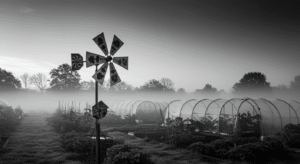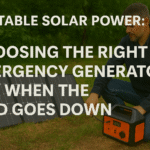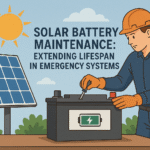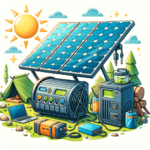In a world where extreme weather events and aging infrastructure increasingly threaten our access to reliable electricity, having a dependable backup power source is more important than ever. While traditional fuel-based generators have dominated the emergency preparedness space for decades, wind turbines are emerging as a greener, quieter alternative. Can a personal wind turbine really keep the lights on when the grid goes dark? Let’s break down the facts and find out if wind energy is the emergency power solution you didn’t know you needed.
Understanding Wind Turbine Technology
Wind turbines convert the kinetic energy of wind into electrical energy using a system of blades, a rotor, and a generator. As wind moves the blades, the rotor spins, generating electricity through electromagnetic induction. This power is then directed through an inverter and, in some cases, stored in batteries for later use.
There are two main categories of wind turbines suitable for individual use: horizontal-axis wind turbines (HAWTs) and vertical-axis wind turbines (VAWTs). HAWTs are more common and efficient, while VAWTs are often appreciated for their versatility and lower noise levels. For emergency backup, small-scale models—typically capable of producing between 400 watts and 10 kilowatts—are preferred.
A basic wind turbine system includes the turbine itself, a tower, a charge controller, an inverter, and battery banks. Depending on setup, some systems may also integrate with solar panels to boost reliability during periods of low wind.
Why Emergency Power Matters
Unpredictable power outages are becoming more common due to extreme weather, wildfires, rolling blackouts, and overloaded grid systems. From hurricanes in the Gulf to blizzards in the Midwest, millions of homes see the power go out every year—sometimes for days at a time.
When assessing your emergency power needs, consider both the frequency and duration of expected outages. Short, infrequent outages might only require minimal backup, while long, recurring disruptions demand more robust solutions. You should also differentiate between essential and non-essential power loads. Appliances like refrigerators, medical equipment, and sump pumps are typically prioritized over lighting and convenience devices.
Why Consider Wind Turbines for Emergency Power?
One of the greatest advantages of wind turbines is that they generate electricity from a completely renewable source. Unlike fuel-based generators that emit carbon dioxide and other pollutants, wind turbines leave virtually no environmental footprint once installed.
If wind is consistently available in your area, a turbine can produce power day or night—unlike solar panels, which are restricted to daylight hours. That continuous energy generation means less reliance on finite fuel supplies, minimizing your exposure during emergencies.
Over time, wind systems can also offer significant cost savings. While the initial investment can be high, the absence of fuel costs and lower maintenance needs can translate into a lower total cost of ownership over the years.

Local regulations may also impose height restrictions, setback rules, or permit fees. It’s crucial to research municipal guidelines before purchasing a system.
Cost Analysis and Return on Investment
The typical upfront costs for a small wind turbine system range from $5,000 to $30,000, depending on size, design, and installation factors. Costs often include structural supports, electrical components, permit fees, and labor.
While turbines have relatively low maintenance costs compared to fuel-based generators, occasional repairs, inspections, and battery replacements can add up over time. The good news? Federal, state, and local incentives can significantly reduce overall expenses. The federal Residential Clean Energy Credit, for example, allows homeowners to deduct 30% of installation costs through 2032.
Depending on usage and location, users may hit a break-even point within 5 to 15 years, making wind turbines a viable long-term investment.
How to Choose the Right Wind Turbine for Emergencies
Start by calculating your emergency power needs. Determine wattage requirements for essentials like your refrigerator, electric stove, communication devices, and medical gear, then multiply that by the number of hours you expect to be off-grid.
Match these numbers to a turbine’s output capacity. For instance, a 1.5 kW turbine might suffice for minimal loads, while a 5 kW system could support a moderate range of appliances. Don’t forget to add an appropriately sized inverter and battery storage to match the turbine’s output.
Choose manufacturers with strong reputations for reliability and customer service. Look for warranties of at least five years, and seek out turbines that meet certifications from regulatory bodies like the Small Wind Certification Council (SWCC).
Installation and Maintenance Essentials
Proper site planning is crucial. A wind site assessment will help you understand average wind speeds, turbulence, and obstructions like trees or buildings. Most turbines perform best with average wind speeds above 10 mph.
Tall towers (30 to 100 feet) allow turbines to access stronger and more consistent winds. Optimal placement is crucial—turbines must be installed upwind from buildings and away from large obstructions.
Wind turbines require routine inspection to ensure longevity. Check for wear on the blades, monitor battery levels, and inspect mechanical parts for rust or damage. Preventive maintenance can avoid breakdowns during critical outages.
How Do Wind Turbines Compare to Other Backup Options?
Gas and diesel generators are the go-to emergency solution for a reason—they’re powerful and consistent. However, they rely on fuel, which may be hard to obtain in crisis situations. They’re also loud, emit exhaust, and require regular maintenance.
Solar panels with battery storage offer quieter operation and lower emissions. But their production halts during cloudy days or at night unless paired with reliable storage. A hybrid system combining wind and solar can offer the best of both worlds, especially in varied climates.
As energy expert Dan Gearino at Inside Climate News notes, “Hybrid renewable systems offer unmatched resilience because they can adapt to changing conditions without relying solely on any single power source.”
Real-World Success Stories
Many off-grid homeowners already rely on small wind turbines to stay powered. For instance, a Colorado homesteader living in a mountainous region reports powering their entire cabin setup with a 5 kW turbine and battery bank—fully independent from the grid for nearly eight years.
Some small businesses, like remote bed-and-breakfasts or farms, use turbines to minimize downtime during outages. These systems allow them to protect perishables, preserve connectivity, and offer uninterrupted service to guests—even in remote areas.
One common takeaway from real-world users: pre-planning and professional consultation make all the difference in performance and satisfaction.
Is a Wind Turbine Right for You?
Ask yourself how often you experience outages, how long they last, and what parts of your life must stay operational during those times. Then consider your local wind resources and budget.
While the investment can be steep, the long-term benefits of reduced fuel dependence, environmental impact, and reliable power security are hard to ignore. If you’re in a windy location and value energy independence, a wind turbine could be a smart, sustainable choice.
Final Thoughts
Wind turbines offer a compelling, eco-friendly alternative to fuel-based generators for emergency power. Their ability to generate continuous electricity—especially when supplemented with solar—makes them a versatile part of any disaster preparedness strategy.
However, they’re not without challenges. Location suitability, regulatory hurdles, and early expenses can complicate implementation. Evaluate your specific needs, and consult professionals to determine if wind fits your emergency energy plan.
For those in the right environment, wind turbines aren’t just a backup—they’re peace of mind when you need it most.






